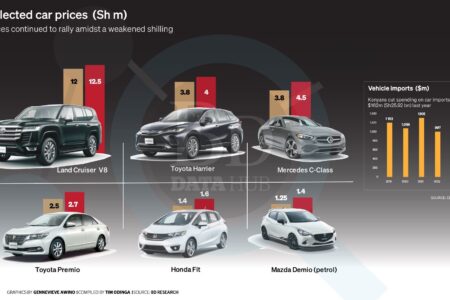Companies
Second hand cars price shocker as imports drop by Sh26bn
Monday February 12 2024
GRAPHIC | GENNEVIEVE AWINO | NMG
The cost of second-hand cars has shot up by up to Sh600,000 in the last four months, fresh data shows, driving them out of reach for more Kenyans.
Industry data shows that the prices of second-hand cars manufactured between 2016 and 2017 have jumped significantly, pointing to the rising cost of ordering the units from abroad that has cut expenditure on motor vehicle imports by double-digits for the second year in a row.
Mercedes C-Class tops the price surges, with a used car now going for Sh4.4 million or more, depending on the dealer, compared to Sh3.8 million in September last year.
A second-hand Toyota Harrier is now retailing at Sh4 million on average in Nairobi, up from Sh3.8 million in September last year, making it costlier for its key middle-class buyers.
The price surge has been driven by the shilling whose market exchange rate to the dollar has shed 14.1 units in the period to trade at 160.4 units currently. Car models with low engine capacity such as Mazda Demio and Honda Fit, which have over the years been popular due to low prices, also recorded significant price increments in the period.
This comes at a time when provisional data from the Central Bank of Kenya (CBK) and the Kenya Revenue Authority (KRA) shows that Kenyans cut spending on car imports by $162 million (about Sh25.92 billion under prevailing conversion rates) last year.
The value of imports amounted to a multi-year low of $835 million compared with $997 million the year before. The 16.25 percent decline came on the back of taxation measures, weakening shilling, rising cost of credit and reduced production of some models.
Read: Used car prices rally on shortage, dollar strength
The Kenya Auto Bazaar Association, which represents second-hand car dealers, has attributed the contraction largely to the slide of the shilling against the dollar, difficulty in accessing bank loans for small traders and eroded purchasing power of households.
As a result, car buyers are increasingly switching to buying locally available units which are older than eight years —the limit for imports.
“The dollar is the key issue affecting volumes of vehicles coming in. Since we are ending up with less dollars for the same amount of shillings, people end up importing less volumes,” the Kenya Auto Bazaar Association secretary-general, Charles Munyori, said on the phone.
“For small traders, the issue of accessing dollars is also a challenge sometimes because anything above $10,000, you have to wait for two to three days for your bank to process.”
The slide in the value of the shilling made car imports more expensive, prompting some dealers to cut orders at a time when demand also dropped.
The KRA increased duty on shipping cars into the country from 25 percent to 35 percent from July last year after the East African Community Council of Ministers approved Kenya’s application to levy a higher rate than the 10 percent common external tariff (CET) for the seven-nation EAC bloc.
Importation of vehicles further attracts excise duty ranging from 25 percent to 35 percent depending on the size of the engine, in addition to the standard 16 VAT.
Excise tax is charged on the sum of the landed cost of the car and import duty, while VAT is applied on the resultant value (the sum of landed cost, import tax and excise duty).
The cost for second-hand car importers went up even higher after the KRA capped the maximum depreciation rate at 65 percent of the value of the vehicle from the previous 70 percent.
Lowering the maximum depreciation rate, which the taxman said last August was in line with other countries within the seven-nation EAC trading bloc, raised the value applied when calculating import duty.
For instance, the cost of a used Subaru Forester is now hovering around Sh3.5 million from under Sh3 million last year, while Toyota Premio is going for about Sh2.7 million from about Sh2 million at the beginning of last year.
Car models popular with operators of the online-taxi hailing services like Uber and Bolt are also priced higher, with the cost of Honda Fit now going for Sh1.6 million compared to Sh1.4 million in September last year.
A used Mazda Demio (petrol engine) is retailing at Sh1.4 million from Sh1.25 million in the same period.
“Business (for second-hand car dealers) is very low and banks have become very strict on financing the purchase of cars,” Mr Munyori said.
Official data shows the expenditure on vehicle imports has fallen from a peak of $1.3 billion in 2021.
The shipments had earlier been hurt by reduced global production of cars in the wake of the disruption caused by the Covid-induced shocks, including a shortage of semiconductors, which are a critical component in modern vehicles.
The falling demand for vehicles caught the eye of Treasury Cabinet Secretary Njuguna Ndung’u who listed them amongst key goods, including fuel and beer, whose flagging sales were being felt on revenues.
Read: Kenyans increase car orders by 25pc despite soaring prices
“The shortfall in excise duty is explained by the decline in oil volumes, motor vehicle imports and deliveries of domestic excisable goods such as cosmetics, beer and spirits,” Treasury officials wrote in the 2023 Budget Review and Outlook Paper (BROP), which was finalised in November.
Kenya allows the importation of second-hand cars within an eight-year age limit, meaning that used units that were manufactured before 2017 will not be allowed into the local market.
Japan, the United Kingdom and South Africa are the leading source markets of used cars that are imported by local dealers.
“Japan has been facing a production deficit due to the cuts that happened when Covid-19 struck and also the shortage of semiconductor chips. Getting some models such as Mazda CX-5 was increasingly becoming difficult,” said another car dealer.
→ (email protected)
→ (email protected)
